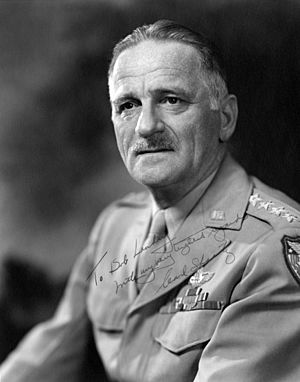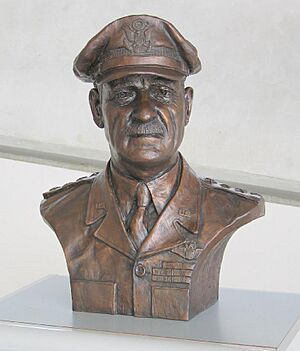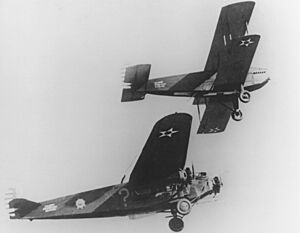Carl Spaatz facts for kids
Quick facts for kids
Carl Spaatz
|
|
|---|---|
 |
|
| Nickname(s) | "Tooey" |
| Born | June 28, 1891 Boyertown, Pennsylvania |
| Died | July 14, 1974 (aged 83) Washington, D.C. |
| Buried |
United States Air Force Academy Cemetery
|
| Allegiance | United States |
| Service/ |
Civil Air Patrol United States Army United States Army Air Service United States Army Air Corps United States Army Air Forces United States Air Force |
| Years of service | 1914–1948 |
| Rank | |
| Commands held | Chief of Staff of the United States Air Force U.S. Strategic Air Forces in the Pacific U.S. Strategic Air Forces in Europe Fifteenth Air Force Twelfth Air Force Eighth Air Force Air Force Combat Command 7th Bombardment Group 1st Pursuit Group Kelly Field 31st Aero Squadron |
| Battles/wars | Mexican Expedition World War I World War II |
| Awards | Distinguished Service Cross Army Distinguished Service Medal (4) Legion of Merit Distinguished Flying Cross Bronze Star Medal |
Carl Andrew Spaatz (born Spatz; June 28, 1891 – July 14, 1974), known as "Tooey", was a very important American general. He played a key role in World War II. As the commander of Strategic Air Forces in Europe in 1944, he pushed for bombing enemy oil factories. This was seen as more important than other targets. In 1947, he became the first Chief of Staff of the new United States Air Force.
Contents
Who Was Carl Spaatz?
His Early Life and Name Change
Carl Spaatz was born in Boyertown, Pennsylvania. In 1937, he added a second "a" to his last name. This was so people would say it correctly, like "spots." His family wanted to make sure it sounded Dutch, not German.
His Nickname "Tooey"
Spaatz got his nickname "Tooey" at West Point. He looked like another cadet named F.J. Toohey. He finished West Point in 1914. He was a second lieutenant in the Infantry.
Becoming a Pilot
He served in Hawaii first. Then, he went to pilot training in California. He earned his pilot rating in 1916. After that, he joined the Aviation Section, U.S. Signal Corps. He served in Mexico with General John J. Pershing. Spaatz was promoted to first lieutenant and then to captain.

World War I Service
When America joined World War I, Spaatz went to France. He commanded the 31st Aero Squadron. He also flew with the 13th Aero Squadron. In a short time, he shot down three enemy planes. For his bravery, he received the Distinguished Service Cross. He was promoted to major in 1918.
Between the World Wars
Flying for a Cause
After World War I, Spaatz led a "Flying Circus." This group flew planes across the U.S. They did air shows to help raise money. This money was used to pay off debts from the war.
Changes in Rank
Spaatz had many changes in his military rank. The military was reorganizing after the war. He went from captain to major and back again several times. This was common for officers back then.
Important Commands and Flights
He commanded Kelly Field in Texas. He also led the 1st Pursuit Group. In 1925, he finished the Air Corps Tactical School. He then worked in Washington, D.C.
In 1929, Spaatz and two other officers made history. They kept their airplane, the Question Mark, in the air for over 150 hours! This was a new aviation record.
He continued to serve in different roles. He commanded the 7th Bombardment Group. He also worked at the Office of the Chief of Air Corps. In 1935, he became a lieutenant colonel. He also visited England during the Battle of Britain in 1940. Before World War II, he became a brigadier general.
World War II Leadership
Leading Air Forces
In 1942, Spaatz became commander of Air Force Combat Command. He was promoted to major general. He then took command of the Eighth Air Force in England. He was in charge of all U.S. Army Air Forces in Europe. He was promoted to the permanent rank of colonel in 1942.
He commanded the Allied Northwest African Air Force in 1943. He also led the Twelfth Air Force and the Fifteenth Air Force. In 1944, he became commander of the U.S. Strategic Air Forces in Europe. He was promoted to lieutenant general.
The "Oil Plan"
As commander of Strategic Air Forces, Spaatz led the bombing campaign against Germany. He oversaw the Eighth Air Force and the Fifteenth Air Force. He worked under General Dwight D. Eisenhower.
In March 1944, Spaatz suggested the "Oil Plan." This plan focused on bombing Germany's oil production. He believed this would cripple their war effort. Eisenhower agreed, and the "Oil Plan" became the top bombing priority. After the war, Eisenhower said Spaatz was one of the two American generals who helped the most to win in Europe.
End of the War
Spaatz was promoted to general in March 1945. After VE Day (Victory in Europe Day), he moved to the Pacific. He commanded the U.S. Strategic Air Forces in the Pacific. From there, he directed the bombing of Japan. This included the atomic bombings of Hiroshima and Nagasaki.
Spaatz was the only general to be present at all three surrender ceremonies. He was at Reims when Germany surrendered to the Americans. He was in Berlin when they surrendered to the Soviets. And he was on the battleship Missouri in Tokyo Bay when Japan surrendered.
Life After the War
In 1945, President Harry S. Truman nominated Spaatz for permanent general rank. In 1946, he became Commanding General of the Army Air Forces. When the United States Air Force became its own branch in 1947, Spaatz made history again. He was named the first Chief of Staff of the new Air Force.
Spaatz retired from the military in 1948. He then worked for Newsweek magazine as a military editor. He also helped advise the Air Force Chief of Staff. He was the first President of the Air Force Historical Foundation. From 1948 to 1959, he was the first Chairman of the Civil Air Patrol's National Board. In 1954, he helped choose the site for the new United States Air Force Academy.
Carl Spaatz passed away on July 14, 1974. He is buried at the Academy's cemetery in Colorado.
Legacy and Honors
Many things are named after Carl Spaatz to honor him:
- Spaatz Island in Antarctica.
- The Civil Air Patrol's highest cadet award, the General Carl A. Spaatz Award.
- He was added to the International Air & Space Hall of Fame in 1977.
- Carl A. Spaatz Field, a regional airport in Reading, Pennsylvania.
- The Carl A. Spaatz Center for Officer Education at Maxwell Air Force Base.
- The National Museum of the United States Air Force is on Spaatz Street.
- General Spaatz Boulevard in Sarasota, Florida.
- The Gen Carl A. Spaatz Trophy for outstanding air refueling squadrons.
- The General Carl "Tooey" Spaatz Award from the Air Force Historical Foundation.
- He was inducted into the Airlift/Tanker Association Hall of Fame in 2002.
- A section of Pennsylvania Route 562 was named after him in 2018.
Awards and Decorations
Carl Spaatz received many awards for his service:
| Distinguished Service Cross | |
| Distinguished Service Medal (with three oak leaf clusters) | |
| Legion of Merit | |
| Distinguished Flying Cross | |
| Bronze Star Medal | |
| Air Medal | |
| Mexican Service Medal | |
| World War I Victory Medal with three battle stars | |
| American Defense Service Medal | |
| American Campaign Medal | |
| Asiatic-Pacific Campaign Medal | |
| European-African-Middle Eastern Campaign Medal with six battle stars | |
| World War II Victory Medal | |
| Knight Grand Cross of the Order of the British Empire (United Kingdom) | |
| Knight of the Order of the Crown with bronze palm (Belgium) | |
| Croix de Guerre with palm (Belgium) | |
| Grand Officer of the Legion of Honor (France) | |
| Croix de Guerre with bronze palm (France) | |
| Commander's Cross with Star (Krzyż Komandorski z Gwiazdą) of the Order of Polonia Restituta (Poland) | |
| Grand Officer of the Order of Orange-Nassau (Netherlands) | |
| Grand Cross of the Order of St. Olav (Norway) | |
| Order of Suvorov 2d Class (Soviet Union) |
Spaatz also received the Collier Trophy in 1944. This was for showing the power of American aviation in the war.
Images for kids
See also
 In Spanish: Carl Spaatz para niños
In Spanish: Carl Spaatz para niños




